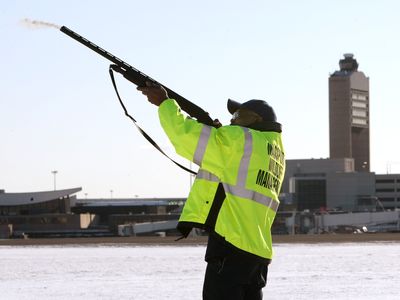Bird-plane strikes common, rising
Cannons, Kool-Aid help scatter flocks

CHICAGO – Collisions between airplanes and birds are common and the hazard is increasing across the U.S. despite sophisticated efforts to control wildlife near airports and track their movements to warn pilots, according to experts.
The majority of bird strikes by aircraft occur at low altitudes – generally about 1,000 feet or below – which was the approximate scenario Thursday when a US Airways jetliner crash-landed in the Hudson River in New York after its two engines stalled due to ingesting birds during takeoff from LaGuardia Airport, authorities said.
Air traffic controllers frequently radio alerts to pilots about bird flocks, based most often on reports from other pilots landing and taking off at airports. But planes that are either in a nose-up climb or in a slow glide path toward landing with engine power reduced simply lack the capacity to execute agile collision-avoidance maneuvers quickly.
About 35 people have been killed in five accidents worldwide since 1975 involving large airplanes hitting birds, according to the Bird Strike Committee USA.
More than 82,000 bird strikes were reported from about 1,600 U.S. airports between 1990 and 2007, the committee said.
The Federal Aviation Administration, the U.S. Department of Agriculture and other government agencies as well as universities have focused for years on wildlife management and experimental programs to reduce the risk of accidents involving birds and planes at airports and the nearby airspace.
The tactics have included placing propane cannons near runways to scare away bird flocks and tests at O’Hare International Airport in which the grape flavoring used in Kool-Aid was sprayed on the airfield as a repellent to irritate the nerve endings in birds’ nasal passages.
Traps baited with live pigeons to catch raptors have also been used successfully, and some airports have tried a laser-beam gun that birds find annoying.
“The measures can work around the airport, but planes get out of the airport environment very quickly and conditions can change from moment to moment,” said Ed Herricks, a research professor at the University of Illinois Center of Excellence for Airport Technology.
Herricks and his colleagues at the University of Illinois are working with the FAA to develop avian radars that detect and track birds and predict the dynamics of their movement so that airplanes can be routed safely. The goal is to create warning systems that offer a high level of accuracy, he said.
It’s a complex effort that is being put to the test with bird radars pointing to the approach and departure paths of runways at O’Hare, Kennedy International Airport in New York, Dallas-Fort Worth International Airport and Sea-Tac International Airport in Seattle.